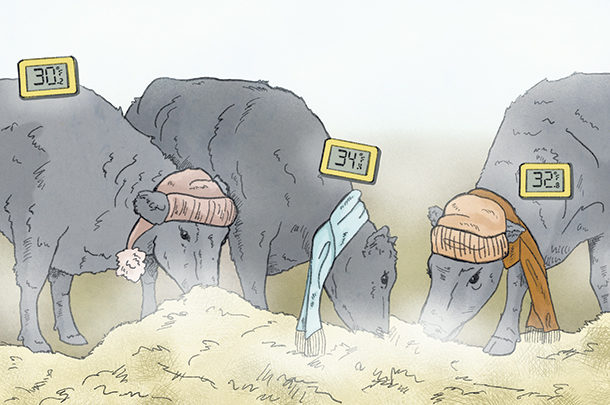In Minnesota and Montana, everyone knows what “cold” means. But if you are a cow on a winter pasture in western Oregon with a rain-soaked fleece after four weeks of 35ºF temperatures, you are suffering from the same cold stress as your cousins in the big-freeze regions.
And then someone drives by in a pickup and tosses some extra hay bales at you because they believe the “heat of fermentation” of that hay will solve your problem. You try to shout “corn, barley, oats” – but you know about these humans. You sigh and bawl a bit, and wish you had accepted that nice job offer in a dry goods store in San Diego.
Livestock, being warm-blooded, all have a “thermoneutral zone” – a range of 30 to 40 degrees in which they don’t suffer from either cold stress or heat stress. The lower boundary of this zone is called the lower critical temperature (LCT). Livestock feel cold stress when the air temperature drops below the LCT. But this LCT is really a moving target because lots of factors influence it.
For example, the LCT is easier to pinpoint in cattle than sheep because cattle don’t wear a woolen outer garment. Cattle with a summer coat have an LCT of around 60ºF. Cattle with a typical winter coat have an LCT of 32ºF. A heavier winter coat lowers their LCT to 19ºF.
Wool, of course, is a better insulator than the hair of cattle (that’s why sheep “wear wool”), but fleeces come in many forms: a dense 2-inch Merino fleece certainly provides a lot more insulation than an open six-month Suffolk fleece. As a general rule, a slick-shorn ewe has an LCT of around 50ºF, while a 2.5-inch fleece lowers the LCT to 28ºF. But if the wool is soaked with rain or blasted by a strong wind, its insulation value drops precipitously.
But I digress. We’re really interested in the effects of cold stress on nutrition. Basically, cold stress affects two major nutritional issues: energy and intake.
Firstly, cold stress increases the “maintenance requirements” of an animal. Actually, this makes sense – cold cattle use more energy to maintain body temperature than cattle in their thermoneutral zone. A higher maintenance requirement, however, means the animal must use more dietary energy just to maintain body heat, leaving less surplus energy to support growth, lactation or pregnancy.
Interestingly, cold stress doesn’t alter the nutritional requirements for protein, minerals and vitamins. Which also makes biochemical sense, really. To generate body heat, animals metabolize carbohydrates and fats, not protein. Only animals in the last stages of starvation will destroy their own proteins to create heat. The bottom line is: Cold stress increases the need for energy and doesn’t alter the need for protein.
Secondly, cold stress induces animals to eat more feed – i.e., their dry matter intake goes up. Increased appetite is probably an evolutionary adaptation to the need for additional energy. (I can still hear my mom saying, “If you want to have more energy, eat more of your supper.”)
Increasing feed intake, however, also increases the rate of passage of that feed through the digestive tract. This means feed passes through the rumen faster, which reduces the time for microbial fermentation, especially of fiber, which reduces the digestibility of that fiber.
Let’s stop and think about this. The classic notion of relying on the “heat of fermentation” of forages to relieve cold stress presumes that the rumen fermentation of forages generates more heat than the rumen fermentation of grains. Whoa – is there a disconnect here? If an animal’s main source of body heat is the cellular metabolism of carbohydrates, and cold stress reduces rumen fermentation of fiber which reduces the heat of fermentation of forages, then why would we rely on this heat of fermentation to combat cold stress? In other words, why would we feed more hay to cold animals? Shouldn’t we really be concerned about an animal’s body condition – which reflects the amount of stored fat – and also about the flow of readily digestible carbohydrates into the system? Rather than feed more hay, shouldn’t we feed grain?
Therefore, when animals are exposed to cold stress, instead of tossing them some extra bales of hay, we might consider increasing the amount of grain in their diets, at least during the period of cold stress. I’ll point out that we’re not trying to fatten these animals or risk a grain overload during this cold period; we’re just giving them some extra readily available carbohydrates to meet their increased need for heat production.
By the way, we’re talking about only a little extra grain here, enough grain to provide a small boost of energy to cope with cold stress. The rest of our basic husbandry hasn’t changed. We still feed hay or silage to our animals. Forage still furnishes most of the daily nutrients during this period. Forage keeps animals happily ruminating next to the feedbunk, it provides their bedding, and it gives us a warm sense of contentment on a cold winter night.
It’s a matter of perspective. A temperature of 35ºF during a Minnesota winter might seem warm, but 35ºF during a rainy Oregon winter would feel cold. Which one results in cold stress? It reminds me of a conversation I recently overheard at a livestock symposium:
A professor asked the crowd, “So, what is the most clever invention in the world?”
One cattleman quickly raised his hand and said, “The thermos bottle.”
The professor was perplexed. “Why?” he responded, “Of all the great advances in technology – penicillin, hot showers, Monday Night Football – why choose the lowly thermos bottle?”
“Because a thermos bottle keeps hot liquids hot and cold liquids cold.”
“What’s so clever about that?”
“How does it know?”









